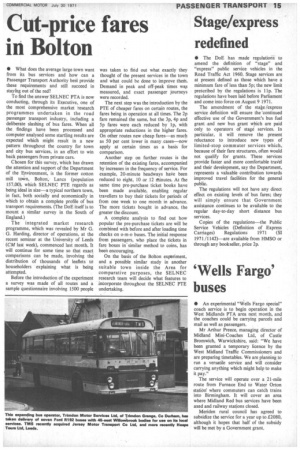Cut-price fares in Bolton
Page 17

If you've noticed an error in this article please click here to report it so we can fix it.
• What does the average large town want from its bus services and how can a Passenger Transport Authority best provide these requirements and still succeed in staying out of the red?
To find the answer SELNEC PTA is now conducting, through its Executive. one of the most comprehensive market research programmes undertaken in the road passenger transport industry, including a deliberate slashing of bus fares. When all the findings have been processed and computer analysed some startling results are expected which might result in a new pattern throughout the country for town and city bus services, in an effort to win back passengers from private cars.
Chosen for this survey, which has drawn the attention and support of the Department of the Environment, is the former cotton mill town, Bolton, • Lanes (population 157.00), which SELNEC PTE regards as being ideal in size—a typical northern town, in fact, both socially and economically in which to obtain a complete profile of bus transport requirements. (The DoE itself is to mount a similar survey in the South of England.)
The integrated market research programme. which was revealed by Mr G. G. Harding. director of operations, at the recent seminar at the University of Leeds (CM last week), commenced last month. It will continue for some time so that exact comparisons can be made, involving the distribution of thousands of leaflets to householders explaining what is being attempted.
Before the introduction of the experiment a survey was made of all routes and a sample questionnaire involving 1500 people was taken to find out what exactly they thought of the present services in the town and what could be done to improve them. Demand in peak and off-peak times was measured, and exact passenger journeys were recorded.
The next step was the introduction by the PTE of cheaper fares on certain routes, the fares being in operation at all times. The 2p fare remained the same. but the 3p, 4p and 5p fares were each reduced by 1 p, with appropriate reductions in the higher fares. On other routes new cheap fares—as much as 50 per cent lower in many cases—now apply at certain times as a basis for comparison.
Another step on further routes is the retention of the existing fares, accompanied by increases in the frequency of service. For example, 20-minute headways have been reduced to eight, 10 or 12 minutes. At the same time pre-purchase ticket books have been made available, enabling regular travellers to buy their tickets for periods of from one week to one month in advance. The more tickets bought in advance, the greater the discount.
A complete analysis to find out how popular the pre-purchase tickets are will be combined with before and after loading time checks on o-m-o buses. The initial response from passengers, who place the tickets in fare boxes in similar method to coins, has been encouraging.
On the basis of the Bolton experiment, and a possible similar study in another suitable town inside the Area for comparative purposes, the SELNEC research team will decide what features to incorporate throughout the SELNEC PTE undertaking.




















































































